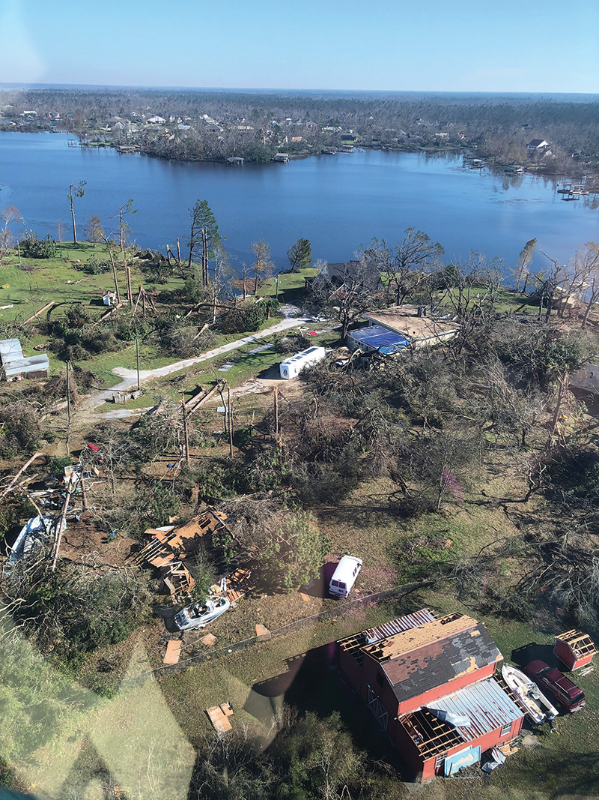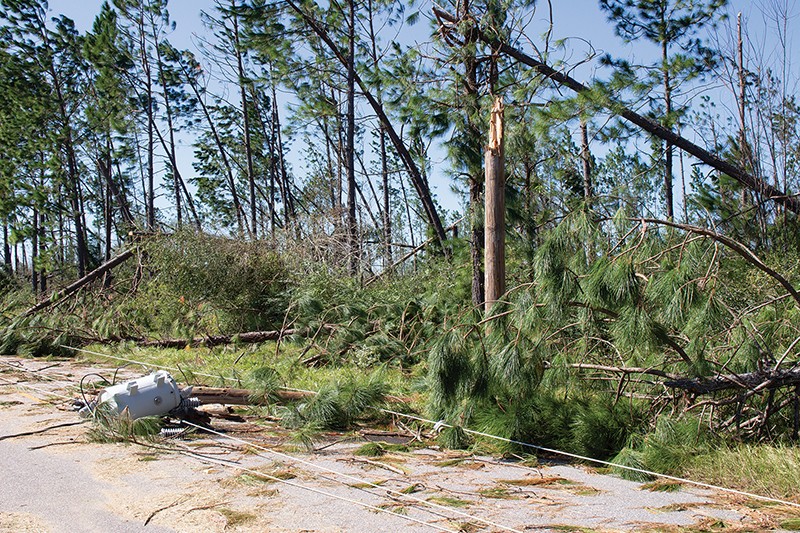Emergency Lines of Credit Help Hurricane-Ravaged Co-ops Recover

Hurricane Michael smashed ashore near Mexico Beach, Florida, on Oct. 10 with sustained winds of 155 mph, making it the most powerful (and only) Category 4 hurricane to ever hit the Florida Panhandle. Power was knocked out to 400,000 customers in the state, and more than 3 million stretching as far north as New York. Three months later, affected residents and businesses are still picking up the pieces.
CFC quickly organized emergency lines of credit (ELOCs) to three of its hardest-hit Sunshine State distribution members: Gulf Coast Electric Cooperative, based in Wewahitchka; West Florida Electric Cooperative, in Graceville; and Talquin Electric Cooperative in Quincy.
CFC RVP Negotiates Hours on Ravaged Roads to Get LOC Papers to Gulf Coast
For Gulf Coast Electric, whose territory lies less than 25 miles from Mexico Beach, virtually the entire system was destroyed. An estimated 4,000 poles were replaced and thousands more damaged, and all 21,000 meters lost power.

In addition, 98 percent of water and wastewater wells and facilities lost service—emergency generators helped at those sites until things came back on-line. Staff worked around the clock, even though the headquarters was left in the dark and without water/sewer services for more than a week.
“Hurricane Michael was the strongest storm to ever hit our service area, and the devastation was worse than anything we could have ever expected,” comments Gulf Coast Electric CEO John Bartley. “We’re extremely thankful to all those who helped us get back on our feet, including 1,700 lineworkers from around the country, and, of course, CFC.”
Following the hurricane, all communications were severed—no e-mail, cell phones, truck radios or Internet. “CFC staff actually drove the emergency line of credit documents to our offices,” Bartley reports. “I have not dealt with a more service-focused financial partner in my career. CFC supported us every step of the way.”
West Florida Taps CFC ELOC For Largest Recovery Ever
The situation was similar for West Florida Electric—only 191 meters out of 28,317 were operating. “Every member who could safely receive power at their location was restored within 28 days,” notes Ty Peel, executive vice president & CEO. “Even now we still have members completing repairs and reconnecting daily. The destruction was unlike anything we had ever seen and many challenges had to be overcome—from technology and communication failures to housing a workforce that swelled to around 1,600 at one point.”
The cooperative used its ELOC to purchase materials and pay vendors, support personnel, contractors and outside line crews. “The process was very quick and very convenient,” asserts West Florida CFO Marie Ashworth. “Once the line of credit was established, it was something we could access daily, if needed. We couldn’t have bounced back like we did without CFC’s help. CFC leadership even took time to reach out to us and say ‘just let us know what you need’ before the weather even hit.”
Talquin EC Hosts More Mutual-Aid Crews Than Ever Before
Talquin Electric service territory surrounds Tallahassee—less than 100 miles from Hurricane Michael’s landfall. About 97 percent of the cooperative’s 54,000 meters were without power and a large portion of the distribution infrastructure destroyed.
“The majority of our members had power back on within 18 days—double the time of Hurricane Hermine in 2016 and about three times longer than Hurricane Irma in 2017,” remarks Talquin Electric CFO Sean Alderman. “We brought in the largest number of mutual-aid crews in our history [more than 500 lineworkers, warehouse personnel and support staff] and replaced more than 1,000 broken poles.”
Pointing to the tremendous assistance CFC provided, Alderman adds, “Having those funds available to pay for outside crews, contractors, hotels, food, fuel, inventory and payroll was a huge relief. Natural disasters are a heavy financial burden for any cooperative. Be prepared with an emergency line of credit.”
Would you like to learn more?
For more information, contact your CFC regional vice president or associate vice president.